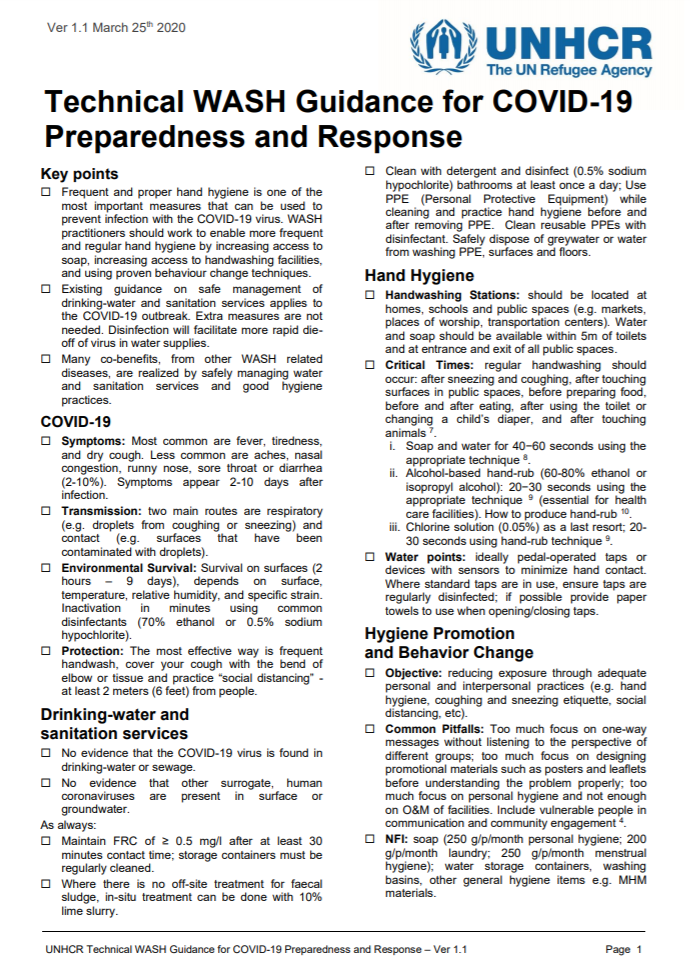 |
Technical WASH Guidance for COVID-19 Preparedness and Response (UNHCR, 2020)The following is a breakdown of key WASH guidance for COVID-19 preparedness and response to support regional and country operations in planning and resource mobilization. These are based on WHO technical guidelines and UNHCR guidance for operations and where relevant operation or site level outbreak preparedness and response plans. |
 |
WASH in Health Care Facilities in Emergencies (WHO, 2011)This document contains recommendations for setting minimum Water, Sanitation and Hygiene (WASH) standards in health-care facilities in emergencies in order to provide an adequate and safe level of health-care in addition to minimizing the risk of health-care facility related infection for patients, staff and carers.
|
 |
Global WASH Cluster Webinar on WASH for Preventing COVID-19PowerPoint PPT presentation from the webinar held on 11 Mar 2020 with WASH Cluster Members providing brief overview of the COVID-19 WASH situation, WASH response, technical resources, and WASH partner updates.
|
 |
The Sphere Standards and the Coronavirus ResponseSPHERE guidance related to how humanitarian actors can best respond to the COVID-19 outbreak including fundamental principles, and relevant standards.
|
 |
Institutional Survey on Menstrual Hygiene ManagementAs part of the operationalization of the Age, Gender and Diversity policy, UNHCR is working to better understand how it is addressing the MHM needs of its persons of concern globally and to support country operations in planning for and responding to those needs. To facilitate this, on MHM Day 2018 the Assistant High Commissioner for Operations announced a global survey of MHM programs. This survey was circulated at the end of 2018 and the results are summarized in this document. |
 |
WASH in the Comprehensive Refugee Response Framework (UNHCR, 2019)This document describes the objectives and underlying principles of WASH programming in the UNHCR Comprehensive Refugee Response Framework, including steps to be taken, and the role of UNHCR. Guidance is provided for all phases of the relief cycle from preparedness to long-term inclusion. |
 |
Large Ferro-Cement Water Tank Design Parameters and Construction Details (UNHCR, 2006)This document contains guidance, material specifications, bills of quantitiy, technical design drawings, and step-by-step constuction photos for three large 45m3, 70m3 and 90m3 circular water reservoirs constructed from ferrocement.
|
 |
How to Support Survivors of GBV When a GBV Actor is Not Available in Your Area (IASC, 2015)The “Pocket Guide” resource package V2.0 is a joint GBV Guidelines and GBV AoR resource designed to provide all humanitarian practitioners with concrete information on how to support a survivor of gender-based violence who disclosed to you in a context where there is no gender-based violence actor (including a referral pathway or GBV focal point) available in your area. The resource package uses global standards on providing basic support and information to survivors of GBV without doing further harm. We encourage adaptation of this resource to your local context with the support of a GBV specialist. |
 |
Guidelines for Integrating GBV Interventions in Humanitarian Action – Essential Actions (IASC, 2015)This document consolidates the “essential actions and minimum commitments” tables from the comprehensive Guidelines on Integrating Gender-based Violence Interventions in Humanitarian Action (“GBV Guidelines”) and each sector-specific Thematic Area Guide (TAG) into one document that can be easily downloaded and/or printed to use as a quick reference tool during the earliest stages of acute emergency response. It is meant to support, but not replace, the comprehensive Guidelines and sector-specific TAGs. These tables provide key recommendations for each thematic area. The sector-specific minimum commitments appear in bold.
|
